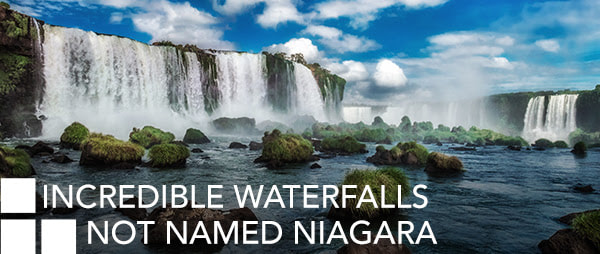|
Nature provides dramatic scenes everywhere, but few more breathtaking than an epic waterfall. In North America, our default idea of an epic waterfall is Niagara. For decades, these three falls – Horseshoe, American and Bridal Veil Falls – have attracted millions of sightseers to the US-Canadian border, and for good reason. Horseshoe Falls alone drops water from a height of 173 feet, spilling 600,000 gallons of its famed green waters per second. But Niagara is not the only waterfalling game in town. Here are four other cascades that put the “awe” in awesome.
Iguazu Falls – The falls at Iguazu National Park, a UNESCO World Heritage Site, are larger than anything in Niagara, with a height of some 240 feet. Iguazu is interesting as it’s made up of a number of cascades thanks to the rock formations shaping the falls direction, and vast sprays are thrown up as the water collides with them. It’s surrounded by lush, subtropical rainforest populated by tapirs, ocelots and jaguars, along with 2,000 plant species and around 400 types of bird. There are a couple of differences in the experiences you can have in each country it borders. The Argentine side of the falls offers a better chance to get close up to the action, while the Brazilian side is better for looking out over the panorama from a distance. Victoria Falls – There are two names in common usage, the Victoria Falls given by UK explorer David Livingstone to honor his queen, and the indigenous name Mosi-oa-Tunya, meaning ‘the smoke that thunders.’ The falls, another UNESCO site, are classified as the world’s largest at 354 feet high; its spray rising to a height of 2,000 feet and can be seen from up to 30 miles away. There have been railways and hotels in the area since the early 20th century, allowing tourism to flourish. The two small national parks on either side welcome thousands of travelers a year in search of the local wildlife such as hippos and rhinos. One of the famous features on the Zambian side is The Armchair, a pool very close to the edge of the falls formed by a rock barrier where brave souls can swim in relative safety. Havasu Falls, Arizona – The striking aspect of the falls, which plunge from around 100 feet, are the vivid colors that can be seen, the bright blue of the water contrasting with the deep red of the surrounding rock face. The color of the water is due to unusually high levels of calcium carbonate and magnesium, and since they originate from an underground spring, their temperature rarely dips below 70F. There are plenty of spots from which to enjoy the views here, including a wide sandy beach, or picnic tables under the shade of the local cottonwood trees. Guided tours are especially popular, leading groups on adventures that usually include camping out near the base of the falls. Plitvice Lakes, Croatia – The falls here are relatively small compared to Niagara and Iguazu, with its two main ones just 225 and 75 feet tall respectively. However, what they lack in height they make up for in beauty, and together with the layered lakes that stack up along the topography, they form one of Europe’s most striking landscapes. Some 16 lakes of varying sizes have formed, and guided tours in English take place every day to help you make the most of your time here. The surrounding national park contains some of Europe’s rarest wildlife, with wolves, brown bears, lynx and wildcats. Again, local guides can help improve your chances of spotting them. You may even be lucky enough to spot a majestic Golden Eagle. Share the knowledge |
AuthorSharing my travel experiences and insights Archives
July 2024
|
|
Click here to schedule a free consultation about your next trip! (408) 718-4872 [email protected] |
Affiliate of KHM Travel Group
California Seller of Travel Registration # 2089491-50. Registration as a seller of travel in California does not constitute the state's approval. Agent is not a participant in the Travel Consumer Restitution Fund. Florida Seller of Travel Registration # ST37113. Hawaii Seller of Travel License # TAR 7231. Washington Seller of Travel UBI # 602 775122.
California Seller of Travel Registration # 2089491-50. Registration as a seller of travel in California does not constitute the state's approval. Agent is not a participant in the Travel Consumer Restitution Fund. Florida Seller of Travel Registration # ST37113. Hawaii Seller of Travel License # TAR 7231. Washington Seller of Travel UBI # 602 775122.
Managed by Voyager Websites


 RSS Feed
RSS Feed




